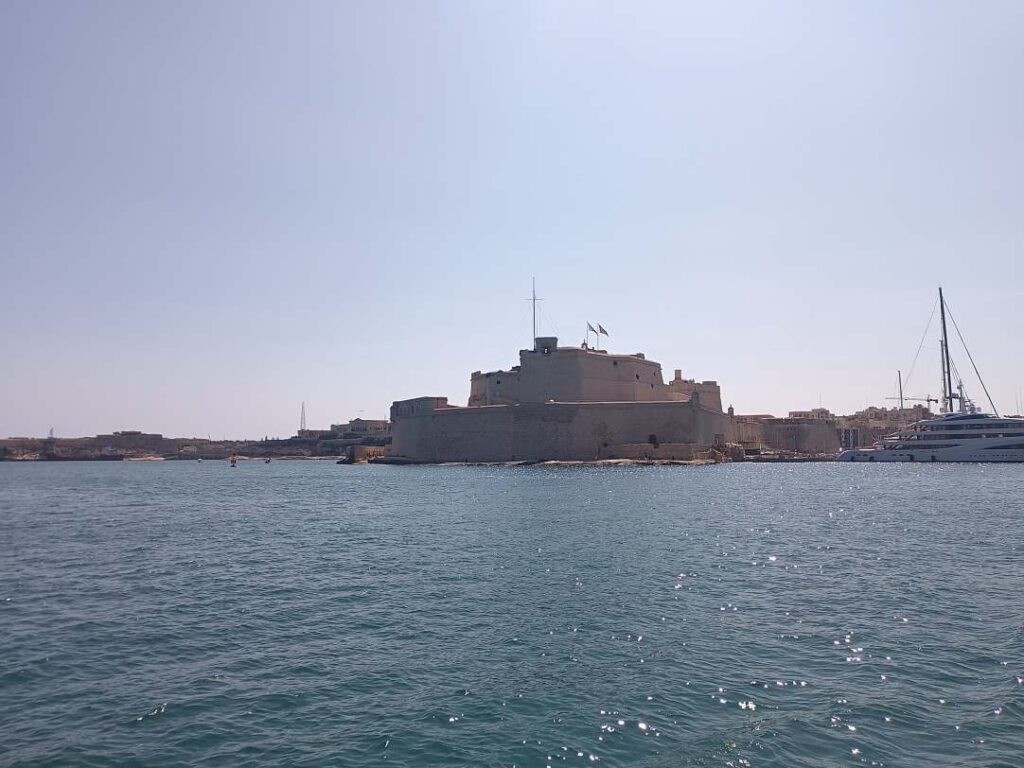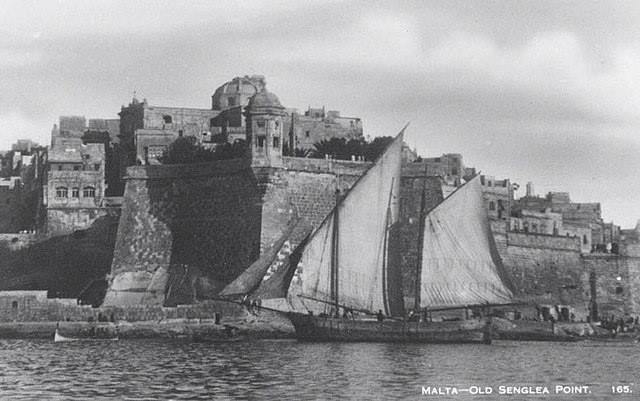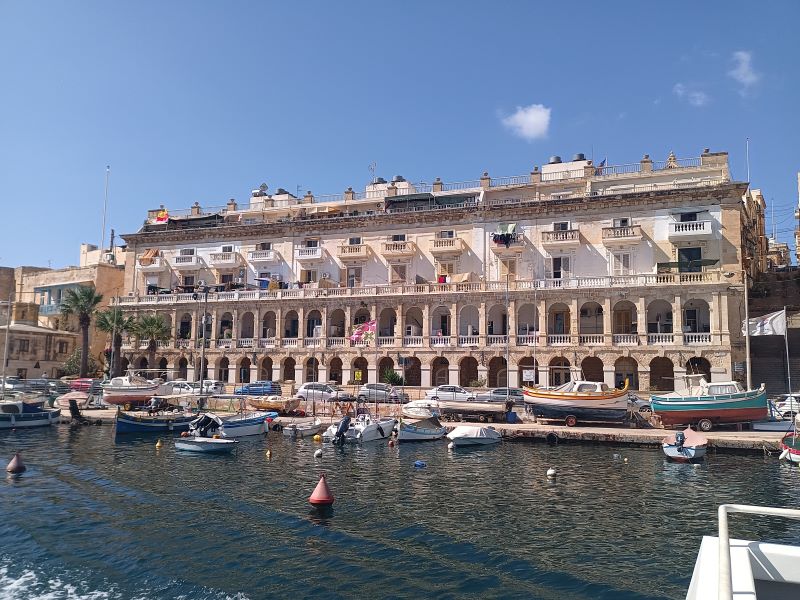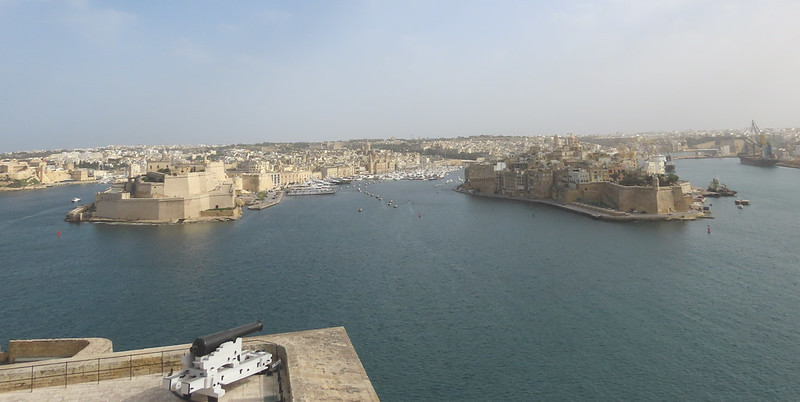| Malta Short Let: Cozy Stay in Gzira | |
|
Sliema Area Modern Designer Finished 2 Bedrooms + Games Room. First floor with Maltese Balcony Large back Terrace with swinging sofa Fully Airconditioned + Full Kitchen 3 TVs, including 65” with backlight. |
 |
|
Book Now: Google Travel | Direct (Cheapest) | Booking.com | Airbnb |
|
Foundations, Fortifications, and Resilience under the Knights (4th Century – 1798)
The Three Cities of Malta—Birgu, Senglea, and Cospicua—each carry unique legacies in Malta’s history. From their ancient origins to their strategic importance under the Knights of St. John, these fortified cities bore witness to some of Malta’s most defining moments. This article explores their evolution, civic structures, and the key events that shaped them, with precise attention to the phases of defense, notable reinforcements, and civic developments within each city.
Pic Credit: Tracey Hind
1. Ancient and Medieval Origins
Bormla’s Ancient Role as Maleth
Known as Maleth in the Phoenician era, Cospicua (or Bormla) served as a “refuge” or “port,” a name that captures its role as a longstanding hub for maritime trade and cultural exchange in the Mediterranean. This early status laid the groundwork for Bormla’s later fortification under the Knights, transforming it into a defensive and civic center.
Formation of the Three Cities
Birgu, the oldest of the Three Cities, was initially part of the Birmula region, which later divided to form the triad of Birgu, Senglea, and Cospicua. Collectively known as the Three Cities, this trio played crucial roles in Malta’s defense strategy and held prominent positions within the fortified Grand Harbour landscape.
2. The Arrival of the Knights and Strategic Foundations
The Knights’ Choice of Birgu as Capital (1530)
When the Order of St. John arrived in Malta in 1530, they chose Birgu as their capital, valuing its strategic location along the Grand Harbour. They expanded the existing Castrum Maris into Fort Saint Angelo, establishing a formidable defensive structure that would come to represent their military and religious mission. This fortification became the heart of the Order’s efforts to protect Malta and Christendom.
Establishment of Dominican Friars in Birgu (1528)
Shortly before the Great Siege, the Dominican Friars settled in Birgu, marking a significant religious development in the area. This foundation introduced a spiritual legacy that blended faith with civic life, further strengthening the community’s resilience and solidarity in the years leading up to the Ottoman threat.
Senglea’s Development under Claude de la Sengle
Originally a hunting ground known as L’Isola di San Giuliano, Senglea’s military potential was realized under Grand Master Claude de la Sengle. In 1552, Fort St. Michael was constructed on Senglea’s tip, reinforcing the city’s defenses against Ottoman incursions. Following the Great Siege, Senglea’s contributions to Malta’s survival earned it the title Città Invicta (Unconquered City).
3. The Great Siege of Malta (1565)

Fortification Efforts and Defensive Preparations
As the Ottoman threat grew imminent, the Knights intensified their defensive efforts. Both Birgu and Senglea were fortified with additional walls and bastions, transforming the cities into well-prepared strongholds. Fort Saint Angelo in Birgu and Fort St. Michael in Senglea were key in these preparations, forming the backbone of Malta’s defensive line.
The Great Siege of Malta in 1565 was a pivotal moment in Mediterranean history. The conflict was characterized by sophisticated military tactics used by both sides – from strategic fort placements to innovative counter-mining operations Military Tactics during the Great Siege. When compared to other historical conflicts, and particularly the Siege of Rhodes, the Malta siege stands out for its sheer intensity and duration. The Knights of Malta’s preparation was significantly aided by their corsairing activities, which not only provided valuable intelligence but also helped finance their defensive preparations Knights’ Corsairing and the Great Siege.
Interestingly, the financial records of the siege reveal a complex economic story from both sides – while the Ottomans poured massive resources into the campaign, the Knights managed their limited funds with remarkable efficiency. The tide of battle turned several times, but the Knights proved particularly adept at exploiting Ottoman mistakes, especially in terms of tactical deployment and resource management. The aftermath of the siege had far-reaching consequences – the Knights emerged with enhanced prestige and began an ambitious building program, while the Ottoman Empire, though still powerful, suffered a significant blow to its expansion plans in the central Mediterranean.
The Maltese people’s experience during this period was transformative, fostering a stronger sense of identity and resilience. Some lesser-known aspects of the siege, such as the role of spies, internal conflicts, and controversial decisions made by both sides (6 Uncomfortable Truths), provide a more nuanced understanding of this pivotal historical event. These factors collectively make the Great Siege a fascinating study in military strategy, logistics, and human determination.
Roles of Birgu and Senglea in the Siege
During the Great Siege of Malta in 1565 with the both sides using their own military strategy, the Three Cities endured sustained and brutal attacks from Ottoman forces. Birgu and Senglea bore the brunt of the assaults, displaying extraordinary resilience. The bravery shown by these cities was recognized with honorary titles: Birgu became known as Città Vittoriosa (Victorious City), while Senglea retained its title of Città Invicta. However the cities won, by their own strength and exploiting the mistakes of the Ottomans.
Piccolo Soccorso (Small Relief) – Initial Reinforcement (July 1565)
In July 1565, the Piccolo Soccorso arrived from Sicily, led by Juan de Cardona. Although this reinforcement was modest in size, its support was crucial in helping the defenders endure the siege’s most difficult phases. The Piccolo Soccorso marked the first significant relief effort in Malta’s defense, sustaining morale amid mounting pressure.
Gran Soccorso (Large Relief) – Decisive Reinforcement (September 1565)
On September 7, 1565, the Gran Soccorso, a much larger reinforcement led by Don García de Toledo, arrived from Sicily. This decisive force turned the tide, overwhelming the Ottoman attackers and forcing their withdrawal. The arrival of the Gran Soccorso was the critical turning point in the siege, solidifying the Three Cities’ legacy as unbreakable fortresses and exemplifying Malta’s indomitable spirit.
4. The Establishment of Civitas Cotonera (1670)
Nicolas Cotoner and the Cottonera Lines
Recognizing the need for further protection, Grand Master Nicolas Cotoner initiated the construction of the Cottonera Lines in 1670. This extensive six-kilometer fortification encircled the Three Cities, serving as a defense against potential landward attacks, particularly those expected from Ottoman forces landing at Marsaxlokk Bay.
Symbolic Foundation Ceremony
The foundation of the Cottonera Lines was marked by a symbolic ceremony, during which coins bearing Cotoner’s seal were cast into the fortifications. Designed by architect Antonio Maurizio Valperga, these lines fortified the entire region, creating a comprehensive barrier against future invasions and reinforcing the strategic value of the Three Cities within Malta’s defenses.
5. Civic and Cultural Flourishing
Religious and Architectural Expansion
The 17th and 18th centuries brought a period of religious and architectural growth to the Three Cities. Key structures, such as the Oratory of the Crucifix in Cospicua (consecrated in 1783) and St. Lawrence Church in Birgu, emerged as major landmarks. These Baroque influences added a cultural dimension to the fortified cities, blending civic life with religious devotion. Including the Inquisition.
Festivals and Processional Traditions
Religious festivals, notably the Feast of St. Lawrence in Birgu, became deeply rooted in the local culture. These events fostered community pride and identity, enriching the area’s spiritual heritage and reinforcing the bond among residents.
See more here : Three cities unique experiences and the Maltese Traditional boats and the Dghajjes-tal-pass.
Elevation of Cospicua as Città Cospicua (1722)
In 1722, Grand Master Marc’Antonio Zondadari granted Cospicua the title Città Cospicua, honoring its importance within the Cottonera Lines and its role as a vital defensive stronghold. This title completed the triad, with each city carrying an honorific designation that reflected its unique contributions to Malta’s defense and heritage.
6. Hospitals, Clock Towers, and the Militia of the Three Cities
Hospitals and the Sacra Infermeria
The arrival of the Knights in Malta in 1530 led to the development and expansion of hospitals, which became central to the Order’s social services. The Sacra Infermeria, established in Birgu in the early 1530s and later relocated to Valletta in 1574, became renowned across Europe for its advanced medical care. It served the Order, civilians, and even slaves, highlighting Malta’s early role as a center of organized healthcare.
In addition, Cospicua had its own local hospices, which provided supplementary care. While the Sacra Infermeria primarily focused on men, a smaller hospital known as the Casetta was established in Valletta in the 1600s to cater specifically to women. These facilities demonstrated the Order’s commitment to social welfare and left a lasting legacy in Malta’s healthcare history.
Clock Towers: Rhythms of Civic Order
Clock towers played an essential role in the Three Cities from the 1500s onward, regulating daily life by signaling times for prayers, curfews, and militia shifts. Their tolls were a constant reminder of both the Knights’ authority and the structured lifestyle they introduced to Malta. Positioned prominently within each city, these towers embodied order and stability, reinforcing the Knights’ control over civic life and ensuring the rhythm of daily activities.
Militia: Defenders of the Cities
Each of the Three Cities maintained its own militia, composed primarily of Maltese civilians who trained to assist the Knights during periods of invasion. This local militia, active from the 1500s, was crucial during the Great Siege of 1565, where they manned the bastions, defended key sites, and provided essential support to the Knights. The establishment of the militia fostered a culture of resilience and pride within the communities, as the Maltese increasingly saw themselves as vital defenders of their homeland.
7. Corsairs and Piracy in the Mediterranean (16th – 18th Centuries)
The Mediterranean was a bustling stage for piracy, and Malta sat right in the middle of the action. Known locally as “corsairs ” (from the Italian “razzia,” meaning “raid”), Malta’s corsairs were sanctioned pirates—authorized by the Knights of St. John to capture enemy ships, especially those from Muslim territories. Unlike freelance pirates, these corsairs operated with the Order’s blessing, which turned Malta into a vital base for privateering using advanced maritime warfare from the 16th to the 18th century.
The Origins of Malta’s Corsairs: Profit and Faith (1560s – 1798)
Once the Knights settled in Malta in 1530, they quickly saw the potential of privateering, both as an economic boost and a way to weaken Muslim powers in the region. Corsairing provided much-needed income since Malta’s land produced little, but it also fit perfectly with the Order’s mission to defend Christendom against the Ottoman Empire. Looting enemy ships wasn’t just tolerated—it was encouraged.
Renowned Corsair Figures and Key Events
- Romegas (Matteo Perez d’Aleccio)
Romegas was a name to remember among Malta’s corsairs. In the 1560s, he became legendary for his daring raids. He didn’t just bring back treasure—he once captured an Ottoman ship so rich in cargo that it strained diplomatic ties between the Knights and the Ottoman Empire. Romegas’s exploits symbolized the Knights’ fierce commitment to defending Malta and Christian Europe. - Ransoms and Slave Markets
The Three Cities became known for their bustling slave market, a byproduct of corsairing. Muslim prisoners, captured at sea, were often held in Fort St. Angelo in Birgu, where they waited to be ransomed. This practice boosted the local economy and gave the cities a reputation as centers of maritime trade and exchange.
The Role of the Three Cities
Birgu, Senglea, and Cospicua were essential bases for Malta’s corsairs . Situated on the Grand Harbour, these cities provided the ideal location for launching expeditions and returning with spoils. Birgu, in particular, was the hub where corsair ships were outfitted, weapons were stocked, and treasure was sorted. The Knights fortified the harbors and built lookout points to protect their activities, blending defense with enterprise.
The End of an Era and Lasting Influence
By the late 1700s, European opposition to corsairing grew as trade routes became more stable, leading to a gradual decline in Malta’s pirates / privateering. When the French took Malta in 1798, they abolished corsairing, ending a chapter in the islands’ history. But the impact of these ventures lived on. The wealth amassed from corsairing contributed to the grandeur of churches, fortifications, and public buildings across the Three Cities, leaving an indelible mark on Malta’s cultural and architectural landscape.
End of part 1:
By the late 18th century, the Knights of St. John had transformed the Three Cities into a fortified and vibrant region, rich with religious, civic, and military significance. With their formidable defenses, symbolic clock towers, dedicated militia, and progressive hospitals, Birgu, Senglea, and Cospicua exemplified Malta’s role as an enduring stronghold in the Mediterranean. Their resilience, symbolized by the titles Città Vittoriosa, Città Invicta, and Città Cospicua, continues to inspire Malta’s cultural heritage and history today.
Part 2: The British Era and Industrial Transformation (1798 – 1945)
The transformative British era, emphasizing how industrialization, social changes, and the impact of two world wars left a lasting imprint on the Three Cities. With their strategic position, these cities became not only a focal point for military and economic growth but also a crucible for community resilience.
1. Transition to British Rule (1798-1800)
The French Occupation and Maltese Resistance
In 1798, Napoleon Bonaparte’s swift seizure of Malta from the Knights of St. John put the Three Cities under French control. The French set up garrisons, including in Fort Saint Angelo in Birgu. However, the French soon faced Maltese resistance, particularly after enacting anti-clerical policies that alienated the largely Catholic population. As tensions mounted, the Three Cities—especially Senglea and Cospicua—became strongholds for the Maltese uprising, supported by British and Neapolitan forces.
The Blockade and the Arrival of the British
The local resistance ultimately led to a blockade against the French garrisons. Maltese forces, supported by British allies, isolated the French until they capitulated in 1800. With the signing of the Treaty of Amiens, Malta became a British protectorate, marking the beginning of over 160 years of British rule / colonization. For the Three Cities, this new era would bring dramatic shifts, particularly through the development of a substantial naval presence.
2. The Rise of the British Dockyard (19th Century)
Expansion of Infrastructure and the Founding of the Royal Navy Dockyard
In the mid-19th century, Dockyard Creek in Cospicua emerged as a crucial hub for British naval operations in the Mediterranean. This expansion was supported by the construction of the Fawwara Aqueduct in 1845, a feat of engineering that rivaled ancient Roman designs, ensuring a reliable water supply for the dockyard and the surrounding communities. To further alleviate water scarcity, public fountains were installed throughout Cospicua in 1846, providing essential access for local residents.
Industrialization and the Role of the Società Operaria Cattolica
The dockyard’s growth brought thousands of Maltese workers into the cities, creating a bustling industrial center. However, this influx also brought overcrowding and growing labor needs. Founded in 1884, the Società Operaria Cattolica in Isla became one of Malta’s earliest welfare organizations, providing social support to workers and their families at a time when government services were limited. This organization laid early foundations for worker rights, shaping the area’s evolving working-class identity.
Introduction of Steam Power and Shipbuilding
By the late 19th century, advancements in steam power transformed operations at the dockyard, allowing for the repair and construction of steamships. This industrial innovation was solidified with the construction of Dock No. 1 in the early 1900s, making Cospicua’s shipyard one of the largest in the Mediterranean. This infrastructure expansion underscored the British investment in the dockyard, cementing the Three Cities as an essential part of Britain’s naval strategy.
3. Social and Cultural Shifts
Educational and Social Developments
To support the dockyard workforce, British rule introduced new educational facilities. The establishment of St. Edward’s College in 1929 in Cospicua provided technical training for local youth, aiming to produce skilled workers essential to dockyard operations. Education became a bridge for economic mobility, helping families integrate more fully into Malta’s growing industrial landscape.
Community and Church Relations
Despite the British Protestant influence, the Three Cities retained a strong Catholic identity. Churches like St. Lawrence in Birgu and the Basilica of the Immaculate Conception in Cospicua continued to play a central role in the community, providing a source of cultural and spiritual unity. Annual religious feasts, such as the Feast of the Immaculate Conception, became even more significant as a way to reinforce Maltese identity and resilience under foreign rule.
4. World War I and the Interwar Period
The Dockyard’s Role During World War I
During World War I, Malta’s strategic location made it an indispensable support center for the British Navy, earning it the title “Nurse of the Mediterranean.” The Three Cities served as vital hubs for hospital facilities, treating injured soldiers, while the Royal Navy Dockyard saw unprecedented activity. This wartime boom brought employment and a temporary boost in prosperity to the area.
Interwar Decline and Social Tensions
Following the war, however, dockyard operations slowed, leading to increased unemployment and economic strain. The Great Depression exacerbated these difficulties, and workers organized strikes to demand fair wages and improved conditions. These social tensions contributed to a politically conscious working class, which would later play a pivotal role in advocating for Maltese independence.
Efforts to Modernize and Develop
Despite economic challenges, the British undertook projects to modernize the Three Cities’ infrastructure, such as a tram system established in 1905 that connected them to Valletta. These improvements sought to address some of the area’s social needs and enhance connectivity with the capital.

5. World War II: The Mediterranean Battleground (1939-1945)
Strategic Importance and Early Attacks
With the outbreak of World War II, the Grand Harbour’s significance placed the Three Cities directly in harm’s way. In early 1941, German bombers launched relentless attacks on the dockyard, and the cities became a focal point of intense bombardment. Civilians adapted by creating underground shelters, demonstrating remarkable resilience in the face of destruction. Dive deep into a comparative analysis on the two sieges.
Intense Bombing and Iconic Losses
In April 1942, the Oratory of the Crucifix in Isla was destroyed in an air raid, and St. Lawrence Church in Birgu suffered extensive damage. The cities endured relentless attacks, and many historic sites were lost. Despite the destruction, the residents displayed extraordinary solidarity, and the community’s spirit became a defining characteristic of the Three Cities during the war.
The Arrival of the St. Mary Convoy (August 1942)
With Malta facing the brink of starvation, the arrival of the St. Mary Convoy in August 1942 proved pivotal. This convoy’s success in delivering critical supplies revitalized morale across the island and cemented Malta’s resilience in the face of Axis powers. For the residents of the Three Cities, the convoy’s arrival became a symbol of endurance and hope.
Post-War Restoration and the Return of Religious Artifacts
In the aftermath of the war, efforts turned to rebuilding the devastated cities. The return of religious artifacts to St. Lawrence Church in 1944 marked a spiritual renewal for Birgu, symbolizing the community’s resilience and dedication to restoring their heritage. Infrastructure restoration projects continued into the 1950s, although the loss of skilled workers to emigration left challenges for full economic recovery.
By the close of World War II, the Three Cities had transformed from historical strongholds into industrial and strategic centers, shaped by the complexities of British rule and the devastation of wartime. Despite the toll of the war, the resilience of the residents and their commitment to rebuilding became a testament to the enduring spirit of the Three Cities.

Part 3: Post-War Rebuilding and Modern Renaissance (1945 – Present)
Focus: This section explores the transformations of the Three Cities after World War II, the role of Maltese leaders like Dom Mintoff, and the socio-economic impact of the dry docks, leading into the cities’ modern-day evolution as cultural and tourism hubs.
1. Post-War Reconstruction and Community Resilience (1945 – 1979)
Rebuilding a Devastated Landscape
The extensive destruction of WWII left the Three Cities in dire need of restoration. Efforts began in the late 1940s, including the careful reconstruction of St. Lawrence Church in Birgu and the return of religious artifacts to Cospicua by 1944, including the statue of the Immaculate Conception. By the 1957 consecration of the new Basilica in Senglea, the Three Cities had made significant strides in restoring their historic and spiritual sites.
Dom Mintoff and the Dry Docks as Economic Lifelines
Dom Mintoff, a native of Cospicua, profoundly influenced the Three Cities, particularly through his emphasis on social programs and the dry docks. As Prime Minister, he championed the modernization and expansion of the Malta Drydocks, recognizing them as vital to Malta’s economy. The dry docks became a major employer in the region, providing stable jobs to thousands in the Three Cities. Under Mintoff’s leadership, the dockyards were expanded, and significant resources were allocated to improve worker conditions and wages. His policies transformed the dry docks into not just a workplace but a symbol of Malta’s industrial progress and self-sufficiency.
Economic Shifts with the British Departure
With Malta’s independence in 1964, the British military’s gradual departure culminated in 1979, celebrated as Freedom Day. The British exit brought both opportunities and challenges, as the Three Cities had been heavily reliant on British naval operations for their economy. The dry docks, which Mintoff had championed, became even more central to the local economy during this transition. However, reliance on the dockyards also meant that shifts in global trade and maritime industries would later pose challenges for the Three Cities.
Shifts in Social Structure
During this period, the Three Cities saw a demographic change as many educated residents relocated, leaving the area predominantly working-class. Social challenges, such as increased welfare needs, were met by resilient community institutions, including the St. George’s Band Club in Cospicua and youth organizations, which continued to foster local pride and unity.
2. Revival and Development Efforts (1980 – Early 2000s)
Preservation of Cultural Heritage and Economic Diversification
As Malta moved into the 1980s, there was a shift towards preserving the Three Cities’ heritage. The Bir Mula Heritage Museum in Cospicua highlighted the area’s rich history, providing residents and visitors with a window into the cultural fabric of the cities. War memorials, including a memorial to dockyard workers in 1992 and the War Victims Memorial in Bormla in 1994, served as important reminders of the community’s resilience and sacrifices.
Challenges Facing the Dry Docks
By the late 1990s, the Malta Drydocks faced economic challenges as global maritime needs shifted. High operating costs led to discussions about downsizing, and while the dry docks continued to operate, the reliance on them began to decline. In the early 2000s, the government initiated efforts to diversify the economy of the Three Cities, recognizing that continued reliance on the dry docks alone would not be sustainable. As a result, areas along the Vittoriosa Waterfront and Dock No. 1 in Cospicua were redeveloped, turning former industrial spaces into commercial and recreational sites. This revitalization attracted both tourists and local businesses, contributing to the cities’ economic renewal.
Public Spaces as Symbols of Rebirth
The Three Cities marked their post-war recovery and ongoing legacy with public monuments and community projects. The Elderly Home inaugurated in 1997 and various war memorials honored the past while underscoring the community’s commitment to caring for its residents. The revitalized waterfront and public spaces underscored the area’s shift from an industrial hub to a space embracing both heritage and modernity.
3. The Three Cities in the 21st Century: Balancing Heritage and Modernity
Notable Visits from Religious and Political Leaders

The Three Cities have welcomed significant figures over the years, reinforcing their cultural and spiritual significance. Pope John Paul II’s visit in 1990 drew thousands of people, marking a moment of unity and faith. Later, in 2010, Pope Benedict XVI followed, adding to the cities’ spiritual legacy. Earlier, King George VI’s visit in 1943 to war-ravaged Senglea showcased international solidarity and the city’s resilience under wartime conditions. These visits underscored the importance of the Three Cities on a global stage, deepening their cultural identity as centers of faith and strength.
EU Membership and Economic Transformation
With Malta’s 2004 entry into the European Union, the Three Cities received funding for further restoration and modernization projects. This included the renovation of Dock No. 1 and other initiatives aimed at reinvigorating the local economy. The opening of the American University of Malta in Cospicua in 2016 reflected the area’s shift toward global collaboration and economic diversity, though it sparked discussions around gentrification and preserving the cities’ unique character.
Cultural Tourism and Modern Attractions
Cultural tourism blossomed with events and sites celebrating the Three Cities’ heritage. The Malta at War Museum in Birgu provided insight into the cities’ WWII experiences, while the Birgu Festival of Candle Lights became a notable annual event, illuminating the area with thousands of candles and celebrating its architectural beauty. The Interactive Science Centre at Bighi Palace, inaugurated in 2016, added an educational attraction, appealing to families and a broad range of visitors.
Local Markets and Community Life
Traditional markets like the Birgu Flea Market and the Sunday Market continued to play a vital role in community life, blending tradition with the influx of tourists. Meanwhile, community initiatives like Kottoner 98FM radio station in Cospicua helped maintain a distinct local voice, ensuring the Three Cities’ cultural identity remained vibrant amidst ongoing change.
4. Future Prospects: Heritage Preservation and Sustainable Growth
Balancing Development with Preservation
As the Three Cities grow in popularity, there remains a delicate balance between fostering tourism and preserving their cultural heritage. Ongoing restoration of historic sites and an emphasis on maintaining affordable housing reflect local efforts to protect the cities’ unique character against the pressures of rapid modernization.

Cultural Legacy and Resilience
The Three Cities’ journey from ancient maritime hubs to modern cultural centers underscores a legacy of resilience. From the Feast of the Immaculate Conception in Cospicua to the Marija Bambina celebrations in Senglea, traditional festivities continue to be central to the community. This blend of past and present, grounded in both everyday life and historical significance, ensures that the Three Cities will remain a cornerstone of Malta’s identity well into the future.
Conclusion: A Living Legacy
Today, the Three Cities stand as symbols of Malta’s ability to balance tradition and progress. As they continue to embrace both heritage and modernity, they illustrate how communities can adapt to change while honoring their past, creating a unique urban landscape where history and contemporary life exist in harmony.








